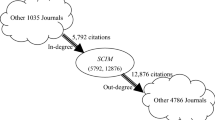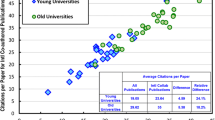Abstract
During the last decade, we have witnessed a sustained growth of South Korea’s research output in terms of the world share of publications in the Science Citation Index database. However, Korea’s citation performance is not yet as competitive as publication performance. In this study, the authors examine the intellectual structure of Korean S&T field based on social network analysis of journal-journal citation data using the ten Korean SCI journals as seed journals. The results reveal that Korean SCI journals function more like publication places, neither research channels nor information sources among national scientists. Thus, these journals may provide Korean scholars with access to international scientific communities by facilitating the respective entry barriers. However, there are no citation relations based on their Korean background. Furthermore, we intend to draw some policy implications which may be helpful to increase Korea’s research potential.
Similar content being viewed by others
References
Borgatti, S. P., Everett, M. G., Freeman, L. C. (2002), Ucinet for Windows: Software for Social Network Analysis. Harvard, MA: Analytic Technologies.
Bornmann, L., Leydesdorff, L., Marx, W. (2007), Citation environment of Angewandte Chemie. CHIMIA, 61 (3): 104–109.
Choung, J.-Y., Min, H.-G., Park, M.-C. (2003), Patterns of knowledge production: The case of information and telecommunication sector in Korea. Scientometrics, 58 (1): 115–128.
Freeman, L. C. (1979), Centrality in social networks: Conceptual clarification, Social Networks, 1: 215–239.
Kim, H., Park, H. W., Thelwall, M. (2006), Comparing academic hyperlink structures with journal publishing in Korea: A social network analysis. Science Communication, 27 (4): 540–564.
Kim, K. (2004), The motivation for citing specific references by social scientists in Korea: The phenomenon of co-existing references. Scientometrics, 59 (1): 79–93.
Kim, M.-J. (2005) Korean science and international collaboration, 1995–2000, Scientometrics, 63 (2): 321–339.
Kim, M.-J., Kim, B.-J. (2000), A bibliometric analysis of publications by the Chemistry Department, Seoul National University, Korea, 1992–1998. Journal of Information Science, 26 (2): 111–119.
King, D. A. (2004), The scientific impact of nations. Nature, 430 (15 July 2004)
Korean Institute Of Science & Technology Evaluation and Planning (KISTEP) (2006), Analysis on the SCI DB Evaluation Research Ability in the Science & Technology Fields in Korea, II. Seoul: KISTEP.
Kostoff, R. (2004), The (scientific) wealth of nations. The Scientist, 18 (18): 10.
Leydesdorff, L. (2007), Visualization of the citation impact environments of scientific journals: An online mapping exercise. Journal of the American Society of Information Science and Technology, 58 (1): 207–222.
Leydesdorff, L., Jin, B. (2005), Mapping the Chinese Science Citation Database in terms of aggregated journal-journal citation relations. Journal of the American Society for Information Science and Technology, 56 (14): 1469–1479.
Leydesdorff, L., Park, H. W. (in preparation), The Journal of Communication and the field of communication studies: Mapping scientific communication online. Unpublished manuscript.
Leydesdorff, L., Zhou, P. (2005), Are the contributions of China and Korea upsetting the world system of science? Scientometrics, 63 (3): 617–630.
Leydesdorff, L., Zhou, P. (2007), Nanotechnology as a field of science: Its delineation in terms of journals and patents. Scientometrics, 70 (3): 693–713.
Park, H. W., Hong, H. D., Leydesdorff, L. (2005), A comparison of the knowledge-based innovation systems in the economies of South Korea and the Netherlands using Triple Helix indicators, Scientometrics, 65 (1): 3–27.
Park H. W., Thelwall, M. (2006), Web science communication in the age of globalization. New Media & Society, 8 (4): 629–650
Wasserman, S., Faust, K. (1994), Social Network Analysis: Methods and applications. New York: Cambridge University Press.
Zhou, P., Leydesdorff, L. (2007), A Comparison between the China Scientific and Technical Papers and Citations Database and the Science Citation Index in terms of journal hierarchies and inter-journal citation relations. Journal of the American Society for Information Science and Technology, 58 (2): 223–236.
Author information
Authors and Affiliations
Corresponding author
Rights and permissions
About this article
Cite this article
Park, H.W., Leydesdorff, L. Korean journals in the Science Citation Index: What do they reveal about the intellectual structure of S&T in Korea?. Scientometrics 75, 439–462 (2008). https://doi.org/10.1007/s11192-007-1862-1
Received:
Published:
Issue Date:
DOI: https://doi.org/10.1007/s11192-007-1862-1




